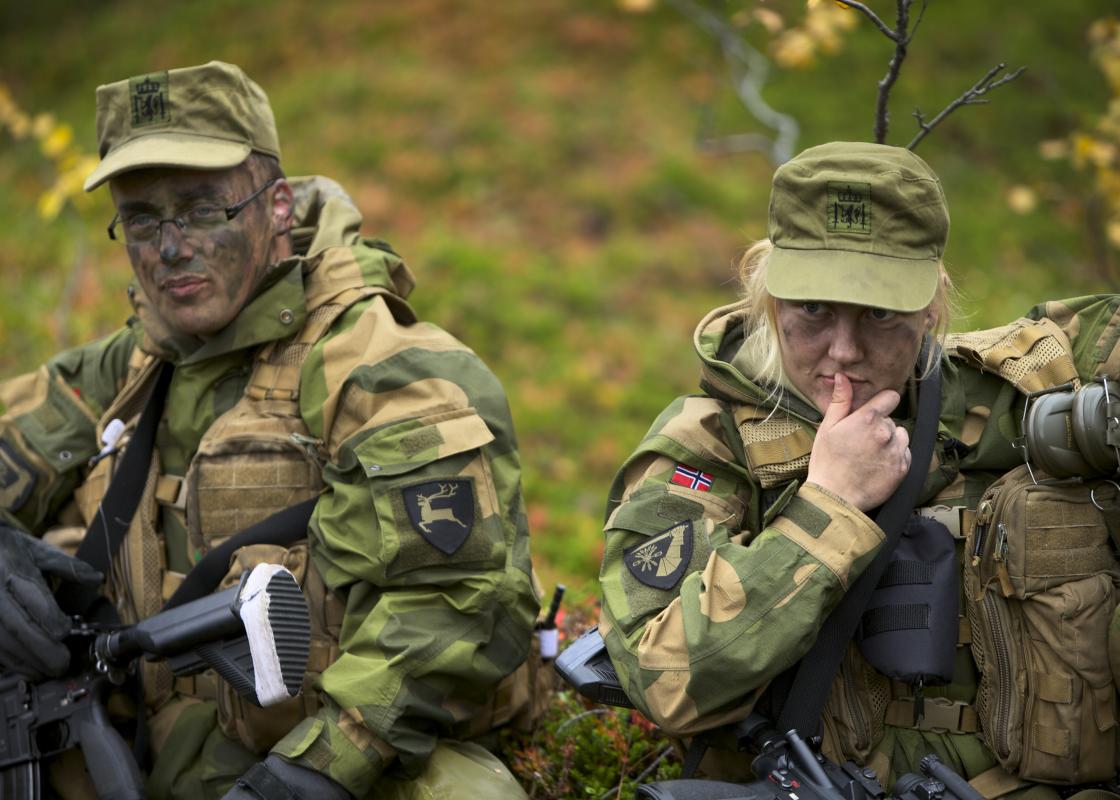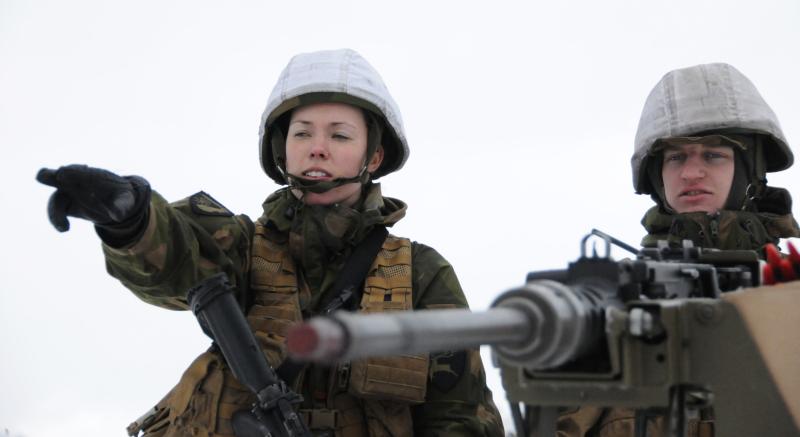Six boys and two girls in the same room in the army, a place known from previous research as a breeding ground for sexual harassment.
“We were very biased. We thought that the girls could not possibly be OK with it, says Ulla-Britt Lilleaas, who, together with Dag Ellingsen, is responsible for the report Forsvaret: Likestillingens fortropp, baktropp og kamparena (“The Army: the vanguard, rear guard and battlefield of equality”).
Before their arrival at the camp, some of the girls had thought along the same lines; for instance the girl who had prepared herself by purchasing large sized underwear.
But instead of finding an increased focus on gender and sexuality, the researchers concluded that the unisex rooms had a “degenderising” effect.
Lilleaas and Ellingsen have studied recruits in the military service who are stationed in Northern Norway. For these recruits, unisex rooms were such a commonplace that the researchers needed to encourage their interviewees in order to make them talk about them.
“To them there was nothing strange about the unisex rooms. They had entered a common mode where gender stereotypes had disappeared, or at least they were less obvious. The uniform was also helping as it was more difficult to see the difference between boys and girls,” says Lilleaas.
“There is no gender in the army”, said one of the interviewees, “there is only green”.
Team mentality
The unisex rooms made it possible to focus more on being in the army, said the young people. At home and at school it was more difficult to be friends with the opposite sex due to all the chatting up, whereas here girls and boys had to become friends.
“You have to be a team here, and then you have to live together in order to be able to trust in one another”, said one of the girls. So it was important that the girls did not form cliques and began slandering, as they had done in school. Unisex rooms were simply a “damn good idea”.
The boys appreciated the fact that it became easier to talk about more important things in life, not only dirty talk, when there were girls present in the rooms.
Motivated girls and boys
Despite the degenderisation, however – most of the girls in the military unit in Northern Norway are afraid that they are not physically adequate. And they are very aware that one girl’s physical defeat affects all of them. “With every one girl who does not succeed there are probably 20 boys who struggle just as much. But, since there are fewer girls, it becomes more obvious when one has to give up”.
Many of the girls believe that the unisex rooms have made it easier to be accepted by the boys.
“Is the degenderisation all about adaptable girls becoming ‘one of the boys’?”
“That is part of the story, but the boys also adapt to the girls. They are much better at taking showers and cleaning, which is being emphasised as a positive thing by the management,” says Dag Ellingsen.
They are not that preoccupied with gender in the unit in Northern Norway – they are preoccupied with the military service. They have all chosen one of the most challenging educations that the army has to offer, the girls included, who make up 10 per cent of the recruits. Ellingsen believes that this may have had an impact on the positive result.
“In this unit, everybody is very motivated for the military service and making it work is a common project. And the girls in the unit seem well aware of what it takes. ”
Problematic girls’ rooms

Compared to the other army institution which has been studied by the researchers, the contrast is substantial. In the recruit education unit in the Royal Norwegian Navy, the girls and boys have separate rooms. Here, gender became a significant distinction among the recruits, and the girls’ rooms were particularly considered as problematic. Bitching, slandering and drama was characteristic of the so-called “girl culture”.
“It becomes us and them, us boys against those girls. And we create stereotypes about each other. But these mechanisms become less obvious with the unisex rooms,” says Ellingsen.
“Another problem with girls’ rooms is that they in some cases fall outside the information flow. And they are often characterised by conflicts and cliques. ”
The researcher believes that this might have to do with the different ambitions among the girls.
“Has the army accepted girls who shouldn’t really be there in order to fulfil political obligations?”
“One may suspect that, and informants who have been part of the system for a long time have pointed in that direction. Another question is whether the army has sufficiently prepared the girls for what is expected of them. What do they know about the physical demands, about getting out in the woods, carrying heavy loads, freezing? It is not very make-up friendly. ”
“Are pure boys’ rooms unproblematic?”
“They are not considered as a problem,” says Ulla-Britt Lilleaas.
“It is a masculine system, thus many things with the boys are taken for granted.”
The girl who couldn’t cope
The girls in the navy’s recruit unit also had a bad reputation due to a couple of urban myths.
“A few girls had added fuel to these stories, either because they did not cope physically or because they, according to some, were constantly hitting on the men,” says Lilleaas.
The stories were about the girl or the girls who had to be carried around the lake or about the girl who lay down on the ground and refused to participate in the military manoeuvres. “Pink girls” had had gone astray into the army and upper class girls were not regarded as being fit for military service.
And there was the boy crazy girls who took photos of themselves in bathing suit and helmet and published them on Facebook.
“The boys do those kinds of things too,” says Lilleaas.
“But whenever boys do silly things like that, it is just the way they are. When girls are perceived as silly, other girls and boys get mad at them.”
Harassment in the male bastion

The extensive report on gender in the armed forces was commissioned in order to find so-called “masculinity cultures” which either promote or restrain gender equality in the army. There is no lack of previous studies which have shown that the masculine military culture harasses women, who are not considered to belong in this male bastion in the first place.
Not even the recruits in the more or less degenderised unit in the north completely escaped this tradition. But in the only case of harassment which was observed there – when a male recruit tried to destroy a girl’s reputation because she refused his attempt to chat her up – it was perceived as unacceptable by the other boys.
The researcher found significantly more examples of sexual harassment and negative masculinity in the navy and in the coastguard. For instance, one set of routines was memorised by the aid of references to the female organs. This was something that the girls figured they just had to put up with.
“They actually didn’t think there was much harassment, they had been prepared for a lot more,” says Lilleaas.
The worst case of harassment took place on a ship. The management had ensured Lilleaas that they were in full control of everything that went on and that they noticed it when things happened. And when Lilleaas resided at the ship there was a good environment and the boys and girls seemed to cooperate well together.
Some time afterwards, four new crew members boarded, but the management did not notice that these four contributed to such an amount of dirty talk that the female crew members perceived it as harassment.
“The girls had to listen to this during breakfast, lunch, dinner and evening meals. Eventually they locked themselves in to their cabins. One became sick and two wanted to quit. These were girls who were originally highly motivated both for the job and for further service as officers,” says Lilleaas.
Read more about sexual harassment here.
Management responsibility
Lilleaas and Ellingsen are highly critical towards the military rule saying that problems should preferably be solved at the lowest possible level. They believe that this may hinder the work against sexual harassment as the cases are never brought into light and properly handled.
They recommend great caution when introducing unisex rooms in other military units.
“The management in the northern unit was probably decisive for making the experiment such a success. The leader was aware of the girls and paid attention to what went on. His door was always open and he wanted to hear too much rather than too little. There wasn’t much that he wasn’t aware of,” says Lilleaas.
“One need to know what one is doing if this should be introduced. Leaders on all levels must be involved and good report systems are crucial. It might also work better at places where there is a strict selection of recruits,” Ellingsen adds.
He believes that gender neutral military service will give the army the opportunity to select the very best of each gender and thus create a more successful and gender equal army.
“I think there are excellent prerequisites for selecting girls who are highly motivated and competent. Moreover, the army can allow itself to be more selective when picking boys. This looks good on the CV – what you acquire in the army regarding social competence and leadership competence is something you don’t get in the university.”
See also: Is the Norwegian military ready for female soldiers?
Contagious enthusiasm
The young people interviewed by Lilleaas and Ellingsen come straight from a “russetid”, the period when one celebrates the completion of secondary school, which is characterised by a great amount of alcohol and sex. In the army they are met with grey walls, dark curtains and Formica floors in a gloomy prison-like institution.
There is strict discipline, breakfast at six a.m. and hard work until eight p.m. There is no internet, they are not allowed to use their phones whenever they want to and they are isolated from the rest of the world. And they love it. So do the recruits in the navy, despite a higher level of conflict and harassment.
The young recruits are so enthusiastic that it has completely rubbed off onto the researchers.
“This has been an energetic project, you get so much energy from talking to exited youth who are so clearly enjoying themselves. Even when they are exhausted,” says Ellingsen, who in his own youth reluctantly completed his military service.
“It is obvious that the army has changed in many ways over the years.”
“If I had known this when I was 20 I would have considered military service. Now I tell all the young girls I meet that they have to join the army,” says Lilleaas.
“Would you take the army off the sick list as regards gender equality?”
“It is just as indicated in the title of the report. The army is a vanguard, a rear guard and a battlefield regarding gender equality. We have found some cases of serious harassment. But that is not an argument against women in the army. If the army uses their experiences from the north with unisex rooms and develops these experiences, they are really coming along. And it is our impression that they are taking it seriously. ”
Translated by Cathinka Dahl Hambro.
Interested in research about gender, peace and conflict? Read about various article on the topic here.
Ulla-Britt Lilleaas is Professor of health science and works at the Centre for Gender Research, University of Oslo.
Dag Ellingsen is a sociologist and works as a senior researcher at the Work Research Institute, which is a subdivision of Centre for Welfare and Labour Research at the Oslo and Akershus University College of Applied Sciences.
Aktuelle lenker
The report Forsvaret: Likestillingens fortropp, baktropp og kamparena (“The Army: the vanguard, rear guard and battlefield of equality”) was commissioned and financed by the Ministry of Defence.
The announced project on masculinity cultures in the armed forces was won by Oxford Research, in collaboration with Professors Ulla-Britt Lilleaas and Michael Kimmel.
The research was carried out from 2011-2013 by Ulla-Britt Lilleaas and project leader of Oxford Research Dag Ellingsen. The report has been commented upon and quality assured by Professor Michael Kimmel.
The research consists of the following parts:
1) A qualitative preparatory project consisting of interviews with 13 individuals, six women and seven men, in advanced positions in the army.
2) A quantitative survey directed towards representative selections of men both in and outside the army.
3) Qualitative case studies.
The case studies were carried out at a military unit in Northern Norway and at a recruit unit in the Royal Norwegian Navy in Southern Norway. An additional smaller case study was carried out at a coastguard ship.
A total of 70 individuals were interviewed, including in-depth interviews with ten girls and ten boys who were interviewed on three different occasions: during the recruit education, after 4-5 months of service, and at the end of their year of service.
The material also includes participatory observations, e-mail and sms communication.

